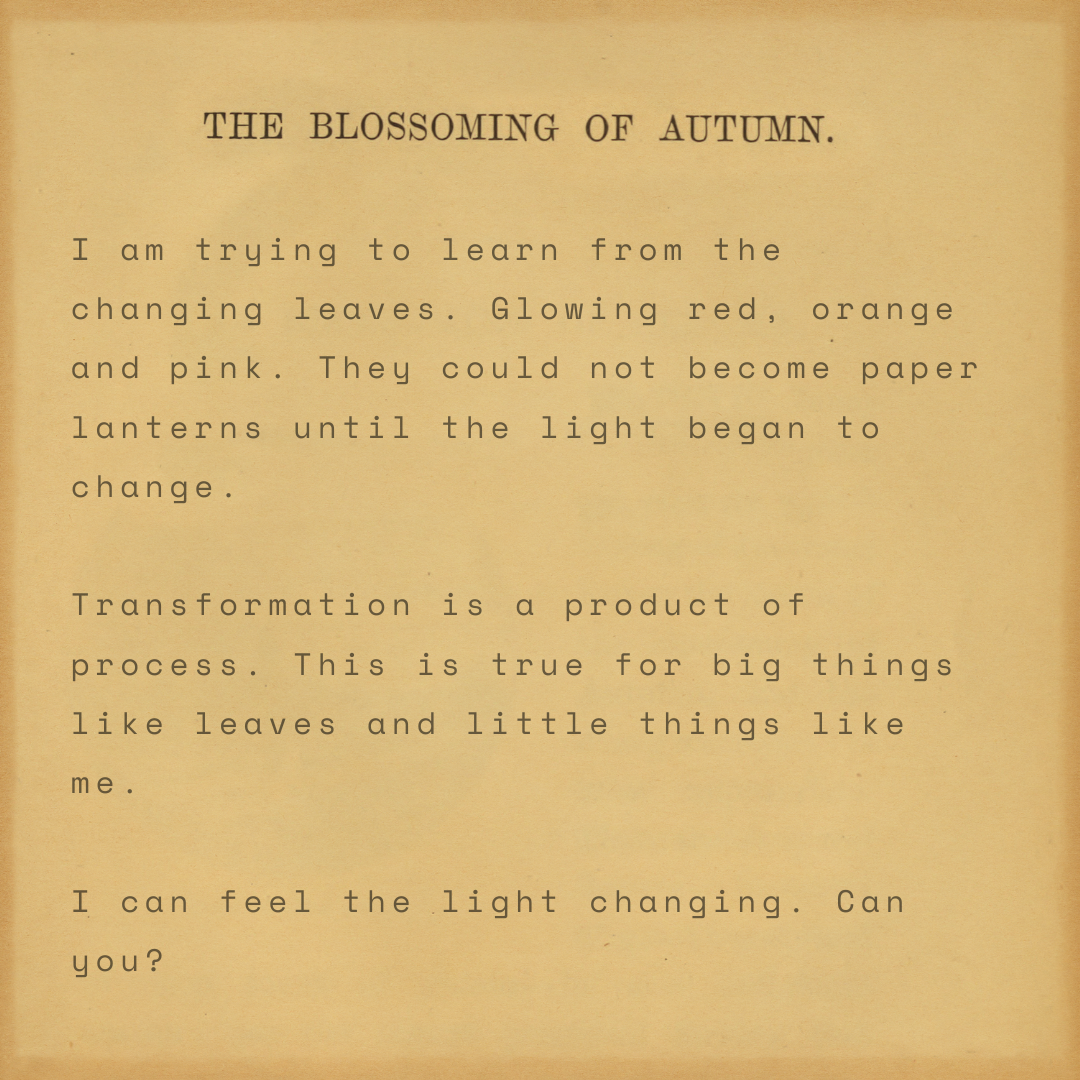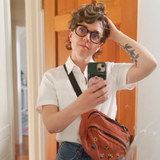October Observance
an exclusive essay and prompts

This material is exclusively for Pocket Observatory members.
Dear Fellow Observer,
This first Observance is getting to you almost two months later than I intended. I’ve fretted over the time it took for me to get everything in order. But I am trying to learn from the changing leaves in the trees. Glowing red, orange and pink. They could not become paper lanterns until the light began to change.
Transformation is an output of process. This is true for big things like leaves and little things like me. I can feel the light changing, finally. Can you?
This month I’d like to pay attention to the light around us.
Part 1 - An exclusive essay and a question
Color is not inherent to matter. It’s a product of how our brains and eyes process light. When electromagnetic waves hit an object, some of the waves are absorbed and some of the waves are reflected. Cones in our eyes detect the reflected waves. The cones relay the information to our brains and our brains turn that information into color. Color only exists if there is light and an observer.
Humans can’t see all light. Our three types of cone receptors can detect the part of the electromagnetic spectrum we call ‘visible light.’ By those lights, humans can detect up to ten million colors. Culture differences influence how we perceive and classify those colors. There are lots of examples of this, but right now I want to focus on the color ‘blue.’
It was uncommon for ancient languages to have a word for the color blue. This doesn’t mean that speakers of those languages couldn’t see the color we now call “blue.” It just means they’d drawn different boundaries through the spectrum of visible light. Our boundaries create a classification we call blue. Theirs did not. The color we call blue was often categorized with green.
Why? Who knows!
One theory is that ‘blue’ is very rare in nature, and so few ancient civilizations developed blue pigment. The Ancient Egyptians are the oldest known civilization to have a word for blue, they also had blue pigment. Blue was mostly adopted into languages once its speakers encountered (or were conquered by) people who spoke languages that included blue.
The Linguistic Relativity Hypothesis argues that large differences between languages lead to large differences in experiences of reality. This hypothesis has a been around in one form or another since at least the 1700s. It’s been used to make very small defensible claims and very big, less defensible claims.
George Orwell invokes linguistic relativity in 1984 - people who can only speak in Newspeak can only think how the government wants them to think. If you’ve seen the movie Arrival, you’ve seen a kind of exaggerated depiction of a linguistic relativity theory called the Sapir Wharf hypothesis.
Someone who was very, very into Linguistic Relativity might claim that a person who does not know there is a word for “blue” cannot experience blue. There are a lot of excellent intellectual arguments and studies that successfully challenge this claim. But there is also something else - how many times have I experienced a kind of understanding for which I have no words? At least not yet?
Still. Language - spoken and silently thought - is the instrument we use to assign meaning, transmit information and compose the parts of us that we call our “selves.” Of course the way we use language to categorize the world impacts what we perceive. And since perception is reality, language plays a large role in shaping reality.
Let’s go back to blue again. The whole “no word for the color blue” thing is often trotted out in service of an Enlightenment view of human progress. Something like,
Humanity is much more evolved than humanity then. Did you know people didn’t even KNOW BLUE in the olden days?! Blue is a primary color! It is one of the three elemental colors from which all other colors can be made! People who don’t recognize the elemental nature of blue, would have also been unfamiliar with many other elemental things!
And here the intersection of classification, taxonomy and authority is laid bare. Because a culture without a word for the color blue is a culture that does not recognize a fundamental of the material world. They do not even know the sky is a color called blue! And so, it’s argued, those people have less authority than people who know the sky is blue. They are ordained with authority, the authority of people who can see things as they truly are.
Only well…it’s all bullshit. The primary color wheel featuring red, yellow and blue is a 19th century fabrication. One of many false taxonomies I learned in school. Red, yellow and blue cannot make all other colors. And other color can be mixed to make red and blue. Blue is not elemental.
When I first learned the primary colors I’d been taught were bunk, the way I saw the world changed. I understood that classifications are no more inherent to existence than color is to objects. Blue lost its authority over creation. We only think the sky is blue because we cannot see most of the light that fills it.
With all of this in mind, I’d like you to consider the classifications that illuminate your reality right now.
Consider something in your experience that seems to fall outside currently accepted classifications. It could be a feeling, a sequence of events, a relationship, a moment, a place, a person, a fear, a hope, a sense, anything. Try to write a definition of this thing and then give it a name. Over the next month, try to observe how naming this part of your experience helped you recognize it.
A list of words that cannot be easily translated into your first language might be a good way to jumpstart this process!
Part 2 - A prompt with instructions (that you can disregard)
Choose a window in your current dwelling-place. Look out of it. What do you see?
Consider taking the time to read Above the Lintel before performing this observance.
You can choose a computer/phone/tablet screen! They are windows into digital environments.
There are many ways to approach this prompt. I decided to map out my own approach through a set of instructions. I am sharing those instructions with you for two reasons!
The first is to just help you brainstorm on your own approach. You may read my instructions to myself and think, “Well…I definitely don’t want to approach it THAT WAY.” Which means I’ve helped you narrow down your process!
The second is that people often ask me how I make the connections I make in my writing. This set of observance instructions is a good example of how I establish my context before I begin to type.
- Before you observe the external environment, please consider your internal environment. Think of your home as an open system, of which you are one part. So if the home is a body, maybe you are an organ. If the home is a universe, maybe you are a force.
- There is an exchange of energy and matter between your home and the external environment. The exchange occurs through ducts, doors, windows, cracks in the wall, leaks in the roof. Think about what comes in through the window - light, heat, sounds. Think about what goes out of the window - light, heat, sounds. What kind of light? What sources of heat? What sounds?
- When a passerby glances at your window, they are receiving information about your internal environment. What might that information be?
- Now! Look out the window for ten minutes. What do you see? How did establishing your context help you see it?
Part 3 - A task you should only do if it doesn't feel like a chore
Over the course of a week, make a list of manufactured lights that light up your memories.
A childhood lamp, stained glass you encountered in a cathedral, the buzzing flourescent light of an office job, a blinker in a car, a front porch light, the light on a screen in a hospital room. Describe them and their context as much or as little as you like. In order to keep this manageable, consider just adding one light a day to your list.
I will send my observations to you as I write them. I’ll also put them into The Observatorium, so you can see them interact with the other Objects.
I will be adding observance-related Objects to the Observatorium each day throughout October. They are tagged with Light and The Pocket Observation Project.
Would you like to see how your observance connects to my observations and other Objects in the Observatoreum? You can can submit them anonymously or with your name attached right here.

